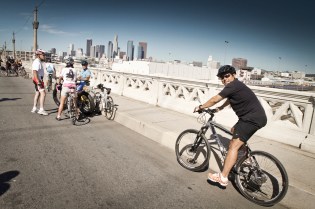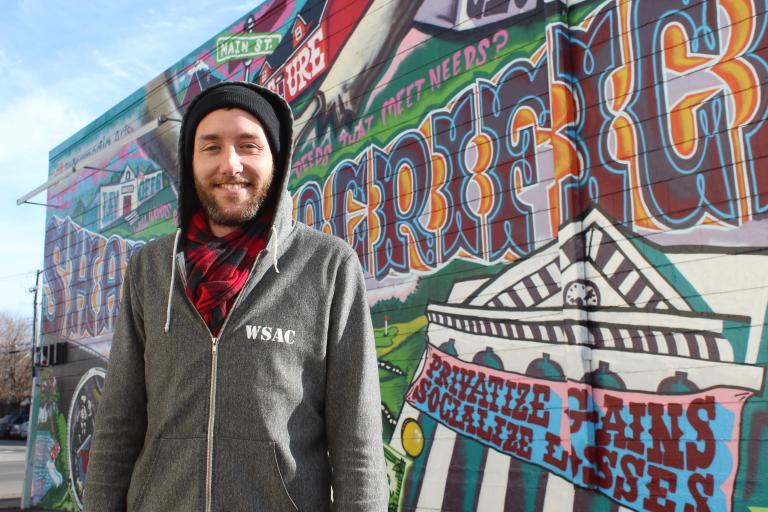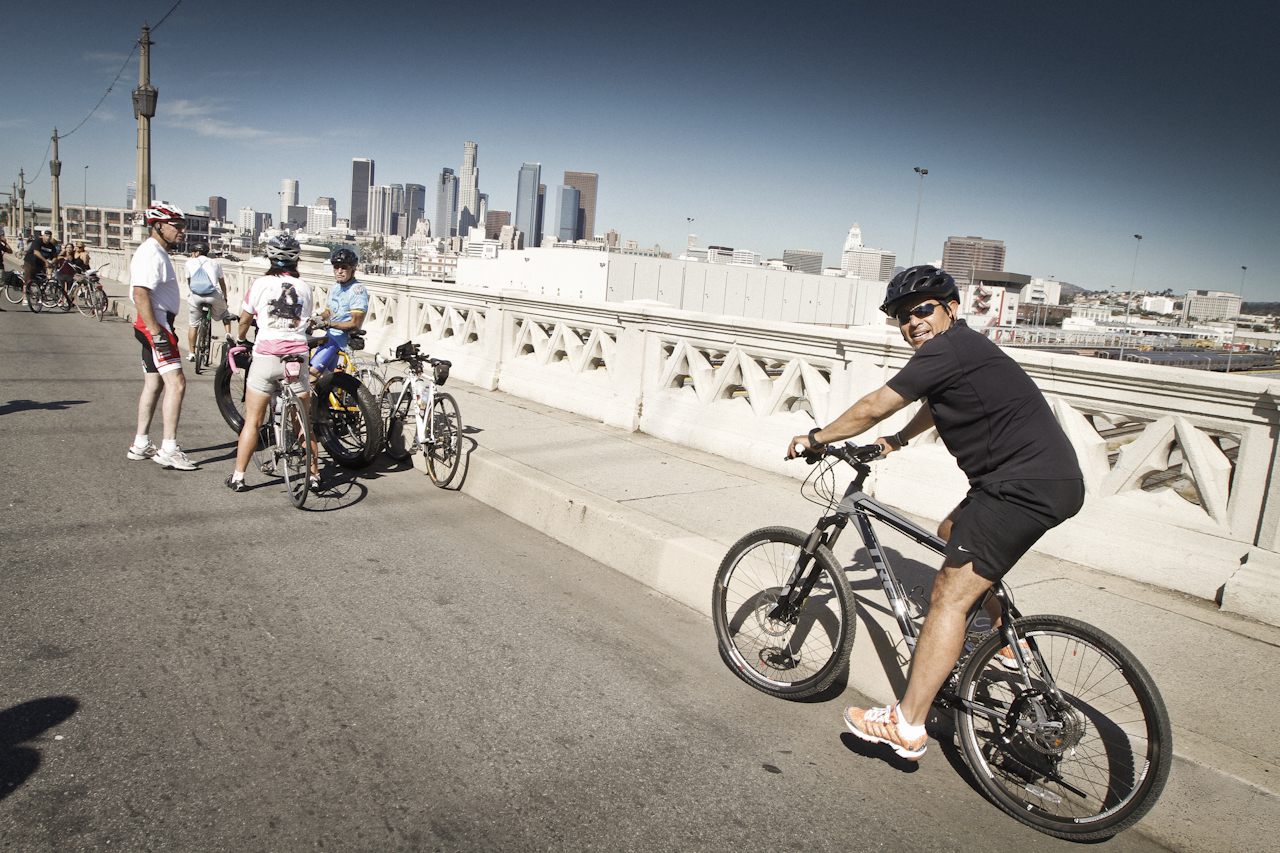
Los Angeles' supergreen mayor, Antonio Villaraigosa. (Photo by David Starkopf.)
Los Angeles Mayor Antonio Villaraigosa is about as green as they come. Since his election in 2005, Villaraigosa has instated a massive climate action plan, slashed air pollution at the Port of Los Angeles, pulled more than 2,000 diesel trucks off the roads, retrofitted more than 64,000 street lights with energy-efficient LEDs, enacted some of the nation’s strictest green building standards, championed the restoration of the L.A. river, created 51 new parks, slashed the city’s water use, increased recycling, and started work on an ambitious mass transit expansion in a city that is famously enamored of the automobile.
Granted, Villaraigosa has a tendency to lay plans that will have no chance of coming to fruition before he is term-limited out in 2013: Build 1,600 miles of bikeways! Plant a million trees! And now he wants to wean L.A. from coal power by 2025. But at a time when most cities are struggling just to meet residents’ basic needs, he can be forgiven for being overly ambitious.
One of Villaraigosa’s policy centerpieces has been Measure R, a voter-approved tax that will raise $40 billion over 30 years to fund transportation infrastructure. Almost half of the money will go to mass transit. And to speed progress, Villaraigosa has convinced Democrats and Republicans in Congress to support a plan called America Fast Forward, which would allow L.A. to get the work done in 10 years, rather than 30 — and similarly reward other cities that are taking on ambitious transit projects.
At press time, America Fast Forward is tied up in Congress, where the House and Senate are engaged in a high-stakes game of chicken over passing a new transportation bill. But political high jinks in Washington aren’t stopping Villaraigosa from dreaming big. He says he’ll move forward with or without help from Washington.
We caught up with Villaraigosa this week to see how he’s managed to stay green in a time when, as a famous frog once lamented, it’s anything but easy.
Q. Are environmental programs really a priority for people during tough economic times, or has being green gone completely out of style?
A. Let’s put it this way: When you have 12, 12.7 percent unemployment, it’s the economy, jobs, jobs, and the economy. So I can’t tell you that it’s popular. But when we get out of this economic crisis, people are going to appreciate that we’re engaged in the most aggressive effort in this city’s history to expand public transit, to clean up our environment, to put us on a more sustainable path.
When I first got elected [to the California State Assembly] back in 1994, the Republicans were coming at Democrats really hard on what I call the jobs blackmail argument. At the time, our Air Quality Management District in Southern California was issuing regulations. I led the charge challenging the idea that cleaning up the air and enforcing environmental regulations was anti-business.
I ran for mayor on a very strong environmental agenda. I had the endorsement of the Sierra Club, the League of Conservation Voters — virtually every environmental organization. I talked about making L.A. the cleanest, greenest city in North America.
Q. Do you think you could win if you were running on that green platform today?
A. Well, now more people are focused on jobs. That’s why we’re focused on the green economy. We put a green technology manufacturing corridor together, which has not taken off because of the economy, but we’re trying to figure how to leverage the fact that L.A. is a cleantech center.
But we put Measure R on the ballot in 2008 in the middle of a recession. We sold it on congestion and public health, but also on the jobs it could create. We needed two-thirds of the vote. We got 67 percent. Angelinos taxed themselves a half penny during a recession. That will generate $40 billion to improve highways, roads, bridges — and about $19 billion will be for public transit.
Q. You’re asking Congress to help you speed up your transit initiatives by passing America Fast Forward. But now it looks like we may not get a new transportation bill because House Speaker John Boehner is refusing to accept a bipartisan compromise passed by the Senate. What will you do if Congress doesn’t pass America Fast Forward?
A. We hope that the House will partner with us, but in the end, we’re moving ahead. L.A. is a city-state. If we were a nation, we’d be the 17th largest economy in the world.
We’re looking at extending Measure R. Right now, it’s a 30-year, $40 billion program. If we extend it indefinitely, it will allow us to bond [the accelerated transit work]. You probably saw that when [Chinese] Vice President Xi Jinping was in town, we sat down with a Chinese investment corporation to explore public-private partnerships.
Q. What does it say about where we are, nationally, that you are going to China to find help with your transportation initiative because you may get no help from Washington?
A. For 60 years, since the national highway system was created by President Eisenhower, every Congress and every president has seen transportation and infrastructure as a bipartisan issue. The fact that we can’t get the House to support a bill that the Senate approved by a vote of 74 to 22, the fact that they [House GOP leaders] wanted to eliminate funding for public transit, is an example of just how extreme the House is, and how partisan this issue has become.
Q. You’ve set some very ambitious goals in terms of bicycling infrastructure as well, but there have been complaints that work is not progressing fast enough.
A. Here’s what’s happening: We’ve got CEQA [the California Environmental Quality Act] to deal with. We get sued. We’re asking for some CEQA relief for bike lanes. I mean, come on, you ask for full environmental review for bike lanes? You see the same kind of things when you get hit for killing birds with wind turbines.
We’re going to hit the 40-mile standard this year — 40 miles [of new bikeways] a year — that’s four times what we used to do. But it has been tough. Homeowners groups have opposed it. Business groups have opposed it. It’s not just restriping lanes, my friend.
Q. You’ve said yourself that L.A. is a city that is built around the automobile.
A. This is a city known for its addiction to the single passenger automobile. It’s a cultural thing.
Still, we have one of the most successful ciclovías in the United States — CicLAvia. We had 100,000 people come out for the first one [in October 2010]. This last one had at least double that number of people. I mean, there were people everywhere. I’ve ridden my bike at every one of them. We had my buddy Lance Armstrong at one.
But you know what you saw with Carmageddon, or Carmaheaven [when a 10-mile stretch of L.A. freeway was shut down for repairs last July]? People are yearning for a day without the automobile. They’re just dying to get on their bike, their skates, or whatever, because we’re so addicted to our automobiles.
Q. What should President Obama and the international community be doing to support environmental initiatives at the city level?
A. When I went to Copenhagen [for the U.N. climate negotiations] in 2009, what was crystal clear to the mayors of the city-states — London, New York, Mexico City, L.A., Paris — was that as the national leaders were outdoing each other to see who could do the least, we were outdoing each other to see who could do the most. I’m looking for the global cities to take the lead in innovation, technology, and sustainability, as they have in all else.
The city-states — Paris, Rome, Singapore — we’re not waiting. We didn’t wait for them [national governments] to sign the Kyoto Protocol. Now there are more than 1,000 mayors who have signed on to Kyoto — this, at a time when national governments are retrenching on the issue of climate change.



